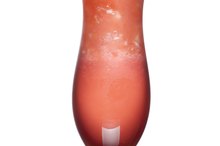How Many Drinks Per Day Cause Cirrhosis of the Liver?
Most retrospective studies have shown that a daily intake of alcohol greater than 4-5 drinks per day for males and about 1.5 drinks per day for females increases the risk of cirrhosis. (ACG practice guidelines intro, p3 ref 6,50) Still, only about 6–40 % of men and women who drink at these levels go on to develop cirrhosis, the advanced stage of alcoholic liver disease 1. (as above) The risks for individuals are less certain because so many additional factors like gender, ethnicity, and co-existing health conditions come into play. If you are concerned about how drinking is affecting your liver, consult your doctor.
If you are experiencing serious medical symptoms, seek emergency treatment immediately.
Define One Too Many
The amount of pure alcohol in different drinks varies widely. By one common definition a drink contains 14 grams of pure alcohol. This would equate to 12 ounces of beer, 5 ounces of wine, or 1.5 ounces of distilled spirits such as scotch, bourbon or vodka. (WJG, Diag of ALD, p3, ref 30) The risk of cirrhosis or other forms of chronic liver disease increase with a daily alcohol intake of >30 grams per day, slightly more than two drinks, according to a report on practice guidelines from the American College of Gastroenterologists 1. (ACG guidelines, Jan.2010, p3, ref 50 1)
- The amount of pure alcohol in different drinks varies widely.
- By one common definition a drink contains 14 grams of pure alcohol.
Risk Factors
Elevated Liver Enzymes and Alcohol
Learn More
Many risk factors can contribute to the progression of Alcoholic Liver Disease, known as ALD, and it’s end stage disease -- cirrhosis. It’s not clear exactly why, but women are twice as sensitive to hepatotoxicity, alcohol-related liver toxicity, and can develop severe ALD at lower doses over a shorter period. (ACG, p.3 ref 55) Ethnicity matters too, and African American and Hispanic males have shown a higher rate of alcoholic cirrhosis compared to Caucasian males with similar drinking habits. (ACG, p. 3 ref 60-62) Other health factors that have shown to increase the risk of liver damage from drinking include obesity, insulin resistance, hepatitis and cigarette smoking. (WJG, Focus on ALD, p 3, ref 49-52 and 4,5).
- Many risk factors can contribute to the progression of Alcoholic Liver Disease, known as ALD, and it’s end stage disease -- cirrhosis.
- ACG, p. 3 ref 60-62) Other health factors that have shown to increase the risk of liver damage from drinking include obesity, insulin resistance, hepatitis and cigarette smoking.
- (
Alcoholic Liver Disease
Alcoholic Fatty Liver Disease, a condition in which fat deposits accumulate in the liver, is one of the early consequences of drinking. In Alcoholic Hepatitis continued damage leads to inflammation and scarring of the liver tissue. Moderate cases of both Alcoholic Fatty Liver Disease and Alcoholic Hepatitis might not produce any obvious symptoms. So, careful examination by your doctor may be the only way to diagnose these conditions. Fortunately, Alcoholic Fatty Liver Disease can be reversed in the majority of people with a simple remedy — temporary abstinence. (A good summary is available on Liverfoundation.org, listed under additional resources)
- Alcoholic Fatty Liver Disease, a condition in which fat deposits accumulate in the liver, is one of the early consequences of drinking.
- Fortunately, Alcoholic Fatty Liver Disease can be reversed in the majority of people with a simple remedy — temporary abstinence.
- (
Cirrhosis
Liver Health and Beer
Learn More
Cirrhosis is a disease that develops over the course of many years. Unfortunately, abstinence will not reverse the course of the disease. Cirrhosis can respond to various treatments that address complicating factors such as viral hepatitis. New drugs are also available to help reduce scarring. RED FLAG: Cirrhosis produces many signs and symptoms including fatigue, itching, and loss of appetite or body weight. As the disease progresses it can produce jaundice -- yellowing of the eyes, skin and tongue -- accumulation of fluid in the feet and abdomen, and black or tarry stools. If you are concerned about any possible signs or symptoms of Cirrhosis seek immediate medical care.
- Cirrhosis is a disease that develops over the course of many years.
- As the disease progresses it can produce jaundice -- yellowing of the eyes, skin and tongue -- accumulation of fluid in the feet and abdomen, and black or tarry stools.
Related Articles
References
- American J Gastroenterology, ACG Practice Guidelines, Alcoholic Liver Disease, Jan. 2010
- World J Gastroenterology, Focus on alcoholic liver disease: from nosography to treatment, July 7, 2014
- World J Gastroenterology, Diagnosis of alcoholic liver disease, Sept 2014
- Centers for Disease Control and Prevention. Fast facts: chronic liver disease and cirrhosis. Updated May 30, 2013.
- National Institute of Diabetes and Digestive and Kidney Diseases. Symptoms & causes of cirrhosis. Updated March 2018.
- Centers for Disease Control and Prevention. Alcohol and public health: frequently asked questions. Updated March 29, 2018.
- Testino G, Leone S, Borro P. Alcohol and hepatocellular carcinoma: a review and a point of view. World J Gastroenterol. 2014;20(43):15943-54. doi:10.3748/wjg.v20.i43.15943
- Dienstag, JL. "Chronic Hepatitis." Harrison's Principles of Internal Medicine 17e. 2008.
Resources
Writer Bio
Shannon George, former editor-in-chief of the trade magazine "Prime," holds a Bachelor of Arts in English from San Diego State University. Her health interests include vegetarian nutrition, weight training, yoga and training for foot races.








